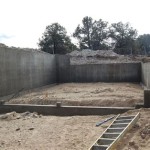The Ultimate Guide to Heating Your Basement: Essential Considerations
Transforming your basement into a comfortable living space requires a well-planned heating system. Here's a comprehensive guide to the essential aspects of heating your basement effectively and efficiently:
1. Insulation: The Foundation of Warmth
Insulation is paramount for basement heating. Ensure that your walls, ceiling, and floor are properly insulated to prevent heat loss and maintain a consistent temperature. Consider using materials such as fiberglass batts, spray foam, or rigid foam insulation.
2. Heating System Types: Exploring Your Options
Depending on your needs and the layout of your basement, various heating systems are available. Here are some popular choices:
- Forced Air Systems: Ideal for large or multi-room basements, these systems use ducts to distribute warm air throughout the space.
- Radiant Floor Heating: Providing gentle and even heat from the floor up, this option is comfortable and energy-efficient.
- Baseboard Heaters: Electric or hot water baseboard heaters offer a cost-effective solution for small to medium-sized basements.
- Heat Pumps: Reverse-cycle heat pumps extract heat from the air or ground outside and transfer it into your basement, providing both heating and cooling capabilities.
3. Heat Source: Fueling Your System
The heat source for your basement heating system can vary depending on availability, cost, and personal preference. Options include:
- Natural Gas: A widely available and relatively inexpensive fuel, natural gas is used in many forced air and baseboard heating systems.
- Electricity: Electric heating systems offer ease of installation but can be more expensive to operate than gas-powered systems.
- Propane: A versatile fuel suitable for areas where natural gas is not available, propane can be used in baseboard heaters and heat pumps.
4. Ventilation: Ensuring Air Quality
Adequate ventilation is crucial to maintain proper air quality in your basement. Install an exhaust fan or a dehumidifier to remove excess moisture and prevent mold growth.
5. Zoning and Temperature Control: Customizing Comfort
Zoning your basement heating system allows you to control the temperature in different areas independently. This can save energy and provide targeted heating where it's most needed.
6. Professional Installation: Safety and Optimization
Proper installation of your basement heating system is essential for safety and efficiency. Hire a qualified HVAC professional to ensure all components are connected correctly and that the system operates according to manufacturer specifications.
7. Maintenance and Inspection: Proactive Care
Regular maintenance and inspections are crucial to keep your basement heating system operating seamlessly. Replace or clean air filters, check for leaks or blockages, and have the system professionally inspected annually to ensure longevity and optimal performance.
Conclusion
Heating your basement requires careful consideration of insulation, heating system type, heat source, ventilation, zoning, professional installation, and maintenance. By following these essential aspects, you can create a comfortable, warm, and energy-efficient living space in your basement, adding value to your home and enhancing its livability.

Top 5 Ways To Heat Your Finished Basement Heating Options

10 Basement Heating Options To Keep You Warm Cozy In Winter

How To Heat And Cool A Basement Tips Best Practices

Basement Heating Options And Solutions

Best Way To Heat And Cool A Basement Homeserve Usa

7 Ways To Cool And Heat Your Basement Rb Heating Climatecare

The Best Way To Heat A Basement And How Keep It Warmer

8 Best Basement Heaters For A Warm And Cozy Winter
.jpg.aspx?strip=all)
What Basement Heating Options Are The Best For My House

Best Ways To Heat A Basement Harmony Basements
See Also








